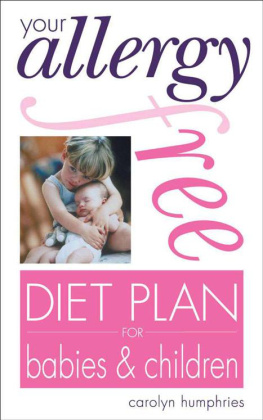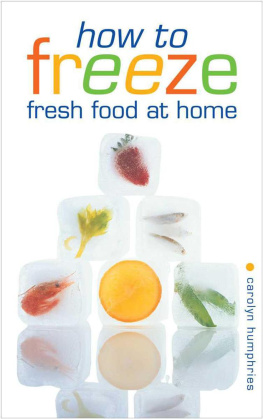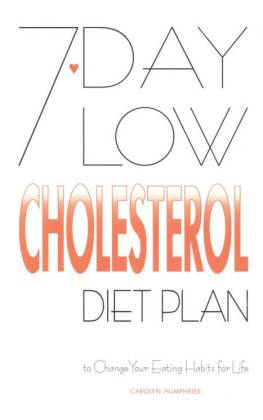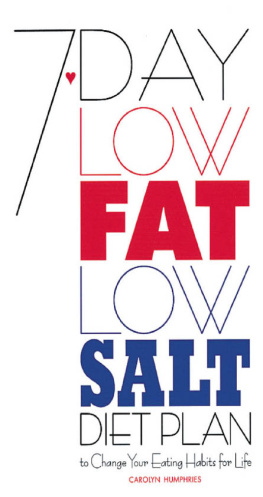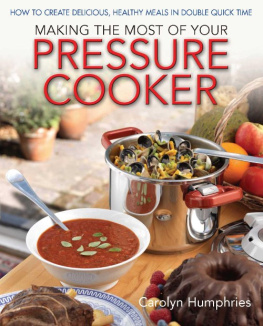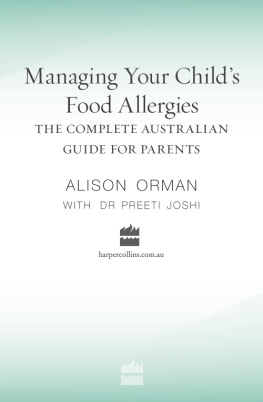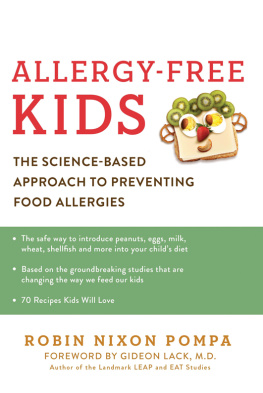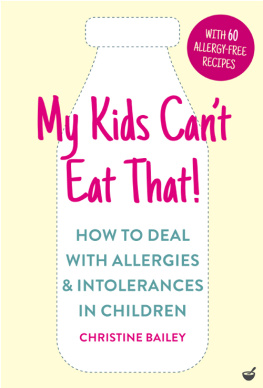
Table of Contents
Introduction
Allergies of all kinds are affecting an increasing number of people of all ages, and when they affect the very young, they can be a particular problem. Babies and young children, for example, can't tell you exactly what is wrong, or assess whether a specific food affects them in one way or another. Allergic reactions can be more severe and - of course - we worry about our children and want the very best for them. In addition, adults may well put up with a substitute recipe or food even if they don't particularly like it because they know they can't tolerate the 'real thing' but a child is just as likely to spit it out if it is not what they like.
The information and the recipes in this book are designed specifically to help you produce a healthy, balanced diet for your baby or child, no matter what allergies or intolerances he may have.
Allergic reactions to food show themselves in many different ways. If your baby or child has a frequent upset tummy or constipation, a rash or persistent cough, or is fractious, difficult to handle or simply not thriving as well as he should, it is possible that he may have a food intolerance or allergy. Thankfully, the majority of children grow out of them by the time they go to school; although a few will have a problem for life. For instance, there is growing evidence that some children with autistic spectrum disorders cannot process gluten or milk protein properly. Marked improvements have been noted when these foods have been eliminated from the diet and suitable alternatives substituted.
If you have concerns about your child, the first thing to do is to take him to your doctor for a full medical assessment. Please note that although I have referred to your child as 'him', there is no significance in this. All the advice in this book applies equally to boys and girls. This book is not designed as an alternative to seeking medical advice. It aims to offer a healthy, nutritious and enjoyable diet for children already diagnosed as having a food allergy or intolerance. It starts with the specific problems associated with babies, and how to wean them on to suitable food - this is particularly important if your family has a history of food allergies. It then moves on to catering for an allergic child.
It's hard enough feeding a growing youngster at the best of times but if you have to cut out many of the most popular foods, the job is that much more difficult. With this in mind, I've created versions of most children's favourites, plus some exciting new dishes, to produce varied, balanced, healthy and enjoyable meals.
All the recipes are free of all the major allergens (wheat, gluten, dairy products, soya, oats, rye, barley and eggs) but I have added a 'variations' box for those who can tolerate some of the foods that commonly cause allergies. So, for example, if your child can tolerate eggs, the variations table lists the quantity of eggs to be used instead of the egg replacer in the main recipe.
I've included a main course section on fish because, although it is an allergen for some, it is a hugely beneficial source of protein, essential fatty acids, vitamins and minerals for most children. Obviously, if your child can't eat fish, simply ignore that section altogether!
Please note that I have included minor allergens, such as citrus fruit and tomatoes, in the recipes, because they will not be a problem for the majority of children. However, wherever these are included, I've given an alternative in the recipe introduction, so you've got the widest range of ideas for great meals for your child every day.
Dealing with Allergies and Intolerances
This chapter looks at the differences between an allergy and an intolerance, and at the specific problems caused by the most common ones. It gives details as to where common allergens hide in processed foods and the best ways to avoid them.
Allergy or intolerance?
It is a common assumption that an adverse reaction to a food is automatically an allergic reaction. This is not strictly true. An allergy involves the body's immune system, whereas an intolerance does not.
Food allergy
When a person has a true food allergy, the body's immune system treats that food (the allergen) as if it is a dangerous alien, like bacteria or a virus. It releases an abnormal antibody that attacks the protein in the offending food. The resultant effect on the body - such as vomiting, diarrhoea, itchy skin rashes, swelling of the face or throat or difficulty in breathing - is called an allergic reaction. Symptoms can develop within minutes after ingestion or may not appear for several hours. In rare, severe cases, anaphylaxis occurs; the sufferer is unable to breathe properly, there is a dramatic reduction in blood pressure and rapid swelling of the mouth and throat. This can lead to severe shock and can be fatal, so medical help must be sought immediately.
True food allergies affect only about 2 per cent of the population in the long term. However, 5-8 per cent of babies and very young children experience some form of allergic reaction to certain foods, which they may grow out of before school age.
If you or anyone in your immediate family has a food allergy, there is an increased chance that your child will have one too. Since it is quite possible to prevent a food allergy occurring in these instances, it is particularly important that you take extra care when you are weaning the child.
Food intolerance
A food intolerance or sensitivity is much more common. It can be serious enough to cause a baby or young child not to thrive and grow properly. Also, it can cause many symptoms: severe colic, tummy upsets and flatulence, persistent runny nose coupled with a persistent cough, eczema, itching with or without skin rashes, asthma or wheezing, bloated or swollen stomach, listlessness, hyperactivity, headaches, aching limbs, frequent crying or mood swings, reflux, constipation and many others. However, I must stress that all children get minor ailments such as runny noses and other cold symptoms and, on their own, these are unlikely to be evidence of food allergies or intolerances.
A food intolerance can sometimes be caused by the lack of an essential enzyme in the digestive system, such as lactase, which is needed to digest lactose, the sugar found in milk.
The major allergens
This section contains information on the major allergens, where to find them and how to avoid them.
Cows' milk
Cows' milk is the most common cause of allergy and intolerance in babies and very young children. The sugar (lactose) contained in milk causes intolerance and the proteins (casein, lactalbumin and lactoglobulin) cause cows' milk allergy.
Lactose intolerance: This is caused when the enzyme, lactase, is not produced in enough quantity in the small intestine; in rare cases it is not produced at all. The body needs lactase to break down lactose into simple sugars so that it can be absorbed. Without it, the lactose passes straight through to the large intestine. Bacteria feed on the unprocessed milk sugar, creating toxins and gas, which cause painful colic, bloating and diarrhoea. The condition is usually inherited.
A child with lactose intolerance can usually cope with some dairy products, especially hard cheeses and yoghurts. Some will also be able to tolerate goats' or sheep's milk; others will react to these in exactly the same way as cows' milk. Trial and error is the only way to work out what suits your child, and there are alternatives to dairy products available, such as soya, pea, oat and rice milks
Next page
